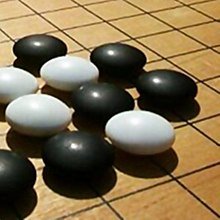| Part of a series on |
| Go |
|---|
 |
| Game specifics |
|
| History and culture |
| Players and organizations |
| Computers and mathematics |
The game of Go (simplified Chinese: 围棋; traditional Chinese: 圍棋; pinyin: ⓘ; Old Chinese: *ɢʷəj grə "surrounding game"[1]) originated in China in ancient times. It was considered one of the four essential arts of a cultured Chinese scholar in antiquity and is described as a worthy pastime for a gentleman in the Analects of Confucius. It reached Korea by the 5th century,[2] in the 7th century it had reached Japan. The game was described by Matteo Ricci in 1615 [3] and by Thomas Hyde in 1694, but it did not become popular in the West until the late 19th century.
According to legend, the game was created as a teaching tool after the ancient Chinese Emperor Yao 堯 designed it for his son, Danzhu 丹朱, to learn discipline, concentration, and balance. Another suggested genesis for the game is that Chinese warlords and generals used pieces of stone to map attacking positions. Other plausible theories relate Go equipment to divination or flood control.
- ^ "Baxter-Sagart Reconstruction of Old Chinese, version 1.1" (PDF). 20 September 2014.
- ^ "history of Go". Sentego. Retrieved 2018-11-09.
- ^ De Christiana expeditione apud Sinas - see: https://senseis.xmp.net/?GoHistory
